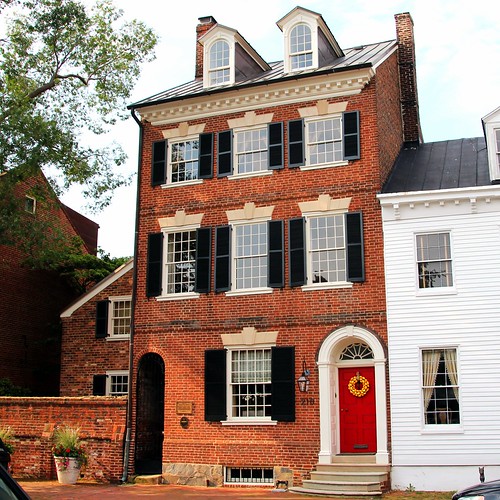It almost goes without saying that there are a large number of truly old homes in the historic district of Old Town Alexandria. As a whole, Old Town represents one of the most densely packed areas in the country when it comes to homes on the National Register of Historic places. While the area represents an important pocket of history in the United States and was one of the first few Federally recognized historic districts, quite a few of the homes have moderate to major historic significance on their own. One such home, the Dr. James Craik house, is the focus of today's Around Old Town.
Simply put, this house is gorgeous. There's just no other way to put it. It's grand, elegant, towering, a classic 18th century townhouse mansion, and an example of a restoration effort not often seen in the early to mid 20th century when similarly dilapidated homes would have been demolished. Just look at the state the house had fallen into by roughly 1930.
However, missing window panes, crumbling mortar, and overgrowth of ivy could do nothing to quash the importance of this home, so efforts to restore it and the neighboring wood frame flounder home to the left have been undertaken at several points since that old photo.
But what's the significance of these two homes? One name can begin to paint a picture.
George Washington
When a site's importance can be quickly conveyed by a simple "George Washington slept here," "George Washington dined here," "George Washington originally owned this land," or "George Washington once thought earnestly about stopping by to ask for a glass of water," it's obvious just how important of a figure President Washington is to the history of America. These two homes (which are now a single dwelling) are absolutely steeped in Washington lore.
The larger home of the two, located at 210 Duke Street, was the home and office of Scottish surgeon, Dr. James Craik.
Built for Dr. Craik in 1796 after his friend George Washington convinced him to move to Alexandria, Craik practiced medicine in the front of the home, while maintaining residence in the rear and on the upper floors. By the time this home was constructed, Dr. Craik had already established his place in history. He was a personal physician to George Washington, the Physician General of the Revolutionary Army, and was at Washington's side at nearly every battle from the French and Indian War through the Revolutionary War. At the time of Washington's death, Dr. Craik was one of the doctors at the iconic president's bedside, and many believe may have ironically been somewhat responsible for Washington's death by allowing Washington to be bleed (a common but becoming quickly antiquated process at the time) to resolve his illness, ultimately making him too weak to recover.
The second home, to the left of the Craik house, is the Coryell house. Today the home is covered in a brick veneer, but the little wood frame flounder home was lived in and may have been built by George Coryell in 1790.
The name Coryell is probably not immediately familiar but is also tied to George Washington's deep history. On Christmas Eve 1776, George Washington and his men stealthily crossed the Delaware River for a surprise attack on the Hessians. The moment, immortalized in this painting, took place on ferries owned and operated by the Coryell family.
Though this image is historic and amazing (with a copy even hanging in The White House), its artist played a little fast and loose with the historical facts. I found this very interesting article about a more accurate representation of what occurred that night, including the more correct style of ferry boat of the Coryell's they most likely used to cross the river.

Mort Kunstler’s “Washington’s Crossing at McKonkey’s Ferry”
Wendy and I tend to walk through the 200 block of Duke Street quite often, and we almost always marvel at the two houses in all of their grandeur, daydreaming about how amazing it could be to live there. We've had the opportunity to tour the home on a few occasions and can attest to the home's interior beauty as well as its functionality as a 21st century residence with all the modern conveniences one could hope for.
The home is so truly historic, but it's also set up to be lived in by a family. The yard is large, kitchen and bathrooms upgraded, and overall living space seems quite comfortable.
The current owners purchased the house several years ago and undertook a refresh effort to preserve the front of the home much as it would have been when it was Dr. Craik's office. They also had a painting made of George Washington visiting Dr. Craik in his office and hung it above the fireplace, showing what a scene in the 1790s may have looked like.
For us, the details of the home are truly wonderful. The long horse pass between the two structures is lined with three hanging copper gas lanterns.
This horse pass led to Dr. Craik's stables at the rear of the property. One of his stable buildings is now a garage at the rear of a home on adjacent Lee Street.
The original masonry in a Flemish bond, floor divisions visible by the masonry, 15 over 15, 12 over 12, 8 over 8, and original dormer window sash, as well as restored shutters with small copper caps to keep rain from penetrating and speeding rot in the exterior embellishment, all combine to make this home about as unique as they come.
And though I'd probably prefer that the flounder to the left have retained its clapboard siding, the fact a small wood frame flounder from 1790 is still standing in the same size and shape is quite amazing.
The small details of the home, such as the boot scrape just outside of the front door...
...or the horse head hitching post just outside of the front door continue the charm on a small scale level.
And a quick glance up to the copper roof reveals two large copper clad dormers of a rather spacious fourth floor.
Legend has it this house may also be one of the most haunted in Alexandria, and it has a lot to do with that fourth floor. But that's another blog story for another day.
Five stories of living space, a large yard with gardens, complete privacy, ideal location, a small historic structure, and historically accurate details throughout make this home perfect in our eyes. This is one of the homes that stands alone as a reason for Old Town Alexandria's designation as an historic district.
Do you have a favorite home in your neighborhood that you always pause to admire? Perhaps the home itself, a beautiful garden, interesting portico, or some other architectural feature that captivates you? If so, we'd love to hear all about it in the comment section, or snap a photo and send it to [email protected] for a chance to be featured in an upcoming "Around Town" segment.

![]()
![]()